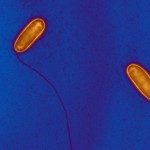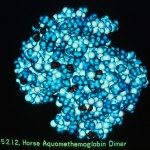Link to Pubmed [PMID] – 37795993
Link to DOI – 10.1128/mbio.01655-23
mBio 2023 Oct; (): e0165523
Legionella pneumophila is a bacterial pathogen ubiquitous in natural and man-made aquatic environments, where it replicates in protozoa. Its intracellular life cycle depends on the establishment of a Legionella-containing vacuole (LCV) where the bacteria replicate. To form the LCV, L. pneumophila depends on a type-4 secretion system that secretes more than 300 proteins in the host cell. Among these is RomA that encodes an N-terminal catalytic methyltransferase domain with a SET fold and a C-terminal domain containing six ankyrin repeats. We have reported that the SET domain has histone methyltransferase activity and specifically methylates lysine 14 of histone H3 during infection; however, the role of the ankyrin repeats is unknown. Here, we report the structure of RomA co-crystallized with a 15-mer peptide corresponding to the N-terminal tail of histone H3 at 2.2 Å. This structure revealed that the N-terminal arm of the peptide from Thr3-Ala7 binds to the ankyrin repeat domain and the C-terminal arm from Gly13-Arg17 and interacts with the SET domain, inserting Lys14 into the active site for methylation. Importantly, the interactions of the five N-terminal residues of the H3-peptide with the ankyrin domains account for ~50% of the peptide-RomA contacts, predicting that the ankyrin domains of RomA are essential for histone H3 binding and subsequent lysine methylation. In vitro enzymatic activity and binding assays confirmed these predictions. Thus, the six ankyrin domains are essential for chromatin binding, thereby allowing the SET domain to fulfill its histone transferase activity and to modify the host chromatin to the advantage of the pathogen. IMPORTANCE Legionella pneumophila is an intracellular bacterium responsible of Legionnaires’ disease, a severe pneumonia that is often fatal when not treated promptly. The pathogen’s ability to efficiently colonize the host resides in its ability to replicate intracellularly. Essential for intracellular replication is translocation of many different protein effectors via a specialized secretion system. One of them, called RomA, binds and directly modifies the host chromatin at a unique site (tri-methylation of lysine 14 of histone H3 [H3K14me]). However, the molecular mechanisms of binding are not known. Here, we resolve this question through structural characterization of RomA together with the H3 peptide. We specifically reveal an active role of the ankyrin repeats located in its C-terminal in the interaction with the histone H3 tail. Indeed, without the ankyrin domains, RomA loses its ability to act as histone methyltransferase. These results discover the molecular mechanisms by which a bacterial histone methyltransferase that is conserved in L. pneumophila strains acts to modify chromatin.





